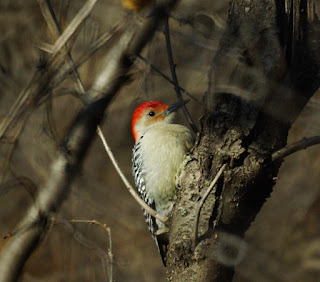11/28/2012
Northern Shrike
Uncommonly seen, a young Northern Shrike Lanius excubitor sat in the Maple tree twitching his tail up and down as he watched for a vole (prospective lunch) below.
11/25/2012
white spot Goldfinch
The American Goldfinches Spinus tristis were feeding this morning on seeds of the birch trees. This Goldfinch looked unusual because of the white spot on his head; it may be an albino variant, or a molting mistake.
boxelder seeds
The Boxelder Acer negundo tree has dropped all its leaves, but the seed pods remain for the birds to enjoy all winter. This cluster, dry and golden in the sunlight, hangs among fading red sumac Rhus leaves on the edge of the woods. The background green is the last-to-drop leaves of the invasive buckthorn Rhamnus.
11/17/2012
larch cones
Although a conifer, the larch is a deciduous tree. In summer it has lush green needle-like leaves; it will lose these golden leaves to the autumn winds as the needles dry out. This tree, Larix laricina, is more than twenty feet tall; it grows on the edge of the woods in the low swale that is constantly moist. This tree is also known as Tamarack Larch or American Larch. Larch are used as a food plant by the larvae of a number of butterflies.
11/12/2012
FeederWatch
Northern Cardinal, White-breasted Nuthatch, Red-bellied Woodpecker, (shown) plus Black-capped Chickadee, American Goldfinch, House Finch, House Sparrow, Bluejay, Junco, Pileated Woodpecker, Hairy Woodpecker, Downy Woodpecker -- the usual birds in the winter guild were all at the feeding stations during the first two days of this season's FeederWatch.
11/09/2012
roost hole
Walking in the woods today, I noticed this hole in an old elm tree. It faces away from the usual windy direction, so probably a good roosting spot for some critter in the winter.
11/07/2012
sunset on wild woods
Most of the leaves have dropped, but the sunset lights the branches, twigs, and remaining leaves atop the wild woods.
11/06/2012
woodpeckers in the wild woods
Today, the female Pileated Woodpecker Dryocopus pileatus came to the suet feeder. She has a smaller red cap than the male, a thinner black eyeline, and lacks the red malar stripe he shows along his cheeks.
This woodpecker nibbled for a few minutes, enjoying the suet. When a chunk broke off and she leaned back, it was impaled on the tip of her lower beak. Unable to eat it while the suet was stuck on her beak, she flew to a nearby tree and perched about four feet up on the trunk. Wiping her beak back and forth, she finally dislodged the suet; it fell into the leaf litter below. She hopped backwards down the trunk to the ground, and shuffled in the leaves until she found her treasure.
This woodpecker nibbled for a few minutes, enjoying the suet. When a chunk broke off and she leaned back, it was impaled on the tip of her lower beak. Unable to eat it while the suet was stuck on her beak, she flew to a nearby tree and perched about four feet up on the trunk. Wiping her beak back and forth, she finally dislodged the suet; it fell into the leaf litter below. She hopped backwards down the trunk to the ground, and shuffled in the leaves until she found her treasure.
Subscribe to:
Comments (Atom)









